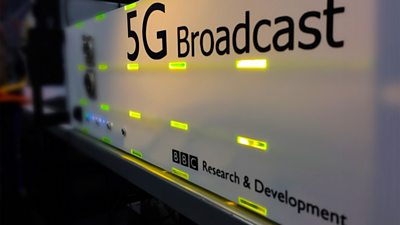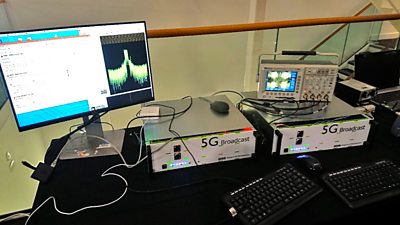�������� Research & Development made the world’s first public demonstration of our newly developed 5G broadcast modem, based on Release-14/15 eMBMS, in Glasgow on 28th March at 5G RuralFirst’s ‘’ event.

5G is very much in the news right now as the next big change in mobile communications. It has the potential to offer much higher data rates and lower latency than 4G can currently provide. What perhaps isn't so well known is that 5G includes other new features. One feature of 5G that is of interest to �������� R&D is that it defines a new, more efficient mode for broadcast use. This could change the way we consume TV and radio while on the move.
IP-based delivery of the ��������’s services is becoming increasingly important and we are keen to understand how 5G Broadcasting might help us to reach our audiences, including those in parts of the UK that have traditionally had more limited Internet connectivity such as rural areas. To help us investigate the possibilities that 5G Broadcast can offer, we developed our own 5G Broadcast modem from scratch (seen above), since there is not yet a commercial implementation of the technology.

Our modem is a complete hardware implementation of a transmitter and receiver and uses the new eMBMS features of including the CAS (Cell Acquisition Subframe) and the ability to dedicate 100% of the available capacity for broadcast. We use the transparent mode of Release 14 where we can carry IP programme streams directly across the RF link. All the signal processing is running on a Field Programmable Gate Array (FPGA) using firmware developed in house. This means our solution is very power efficient compared to a software approach and has allowed us to incorporate real time diagnostic and debugging functionality. Developing the firmware in house also means we can try modifications to the signal to see if improvements can be made which can be incorporated into future releases of the 5G LTE standard. Each unit can be configured to operate as a modulator or receiver and has been designed to run from a 12 volt supply so we can use it in a vehicle to test mobile reception. We hope to take our equipment, which will include some additional features not yet demonstrated, to in September this year.

This milestone continues a strong track record by �������� R&D of developing and demonstrating early modulating and receiving equipment for modern broadcast standards, for instance DVB-T and DVB-T2.
Earlier I mentioned the event. We joined the in 2018 along with other industry and academic partners. This programme is part funded by the UK government through the . The aim is to investigate new approaches to the deployment of connectivity in rural locations and covers a number of areas such as agriculture, tourism, renewable energy and manufacturing that operate in rural environments as well as broadcasting.

One aim of 5G RuralFirst is to test whether 5G, as currently specified, is capable of delivering broadcast services in a variety of environments. To test this, �������� R&D is conducting a trial in one of the most remote parts of the UK - . This trial has been incredibly successful so far and our 5G modem is another significant contribution to the 5G RuralFirst project.
- -
- �������� R&D - All of our articles on 4G and 5G including:
- �������� R&D - Broadcasting Over 5G - Delivering Live Radio to Orkney
- �������� R&D - 4G & 5G Broadcast
- �������� R&D - TV Over Mobile Networks - �������� R&D at the 3GPP
- �������� R&D - 5G-Xcast
- �������� R&D - 4G Broadcast for the Commonwealth Games 2014
- �������� R&D - 4G Broadcast technology trial at Wembley 2015 FA Cup Final
- �������� R&D - 4G Broadcast: Can LTE eMBMS Help Address the Demand for Mobile Video?
- �������� R&D - 5G Trials - Streaming AR and VR Experiences on Mobile
- �������� R&D - 5G Smart Tourism Trial at the Roman Baths
- �������� R&D - New Content Experiences over 5G Fixed Wireless Access
- �������� R&D - New Audience Experiences for Mobile Devices
- �������� R&D - Unlocking the Potential of 5G for Content Production
- �������� R&D - Broadcast Wi-Fi